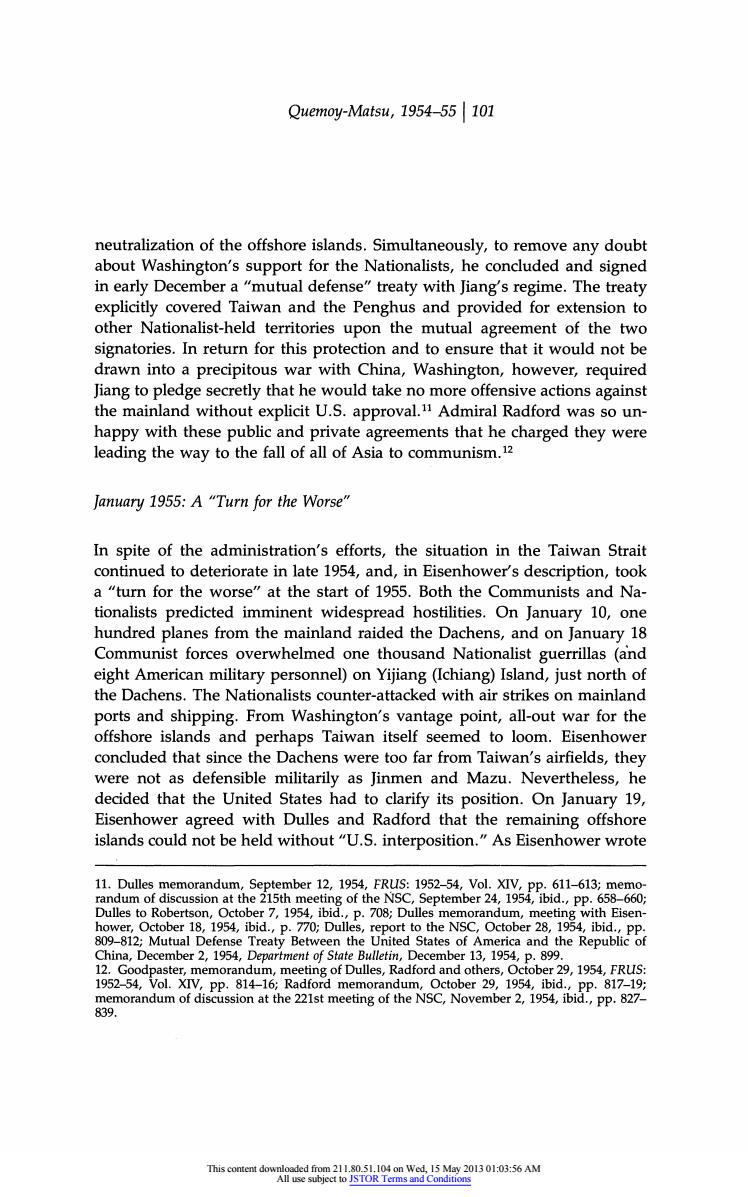正在加载图片...

Quemoy-Matsu,1954-55 101 neutralization of the offshore islands.Simultaneously,to remove any doubt about Washington's support for the Nationalists,he concluded and signed in early December a"mutual defense"treaty with Jiang's regime.The treaty explicitly covered Taiwan and the Penghus and provided for extension to other Nationalist-held territories upon the mutual agreement of the two signatories.In return for this protection and to ensure that it would not be drawn into a precipitous war with China,Washington,however,required Jiang to pledge secretly that he would take no more offensive actions against the mainland without explicit U.S.approval.Admiral Radford was so un- happy with these public and private agreements that he charged they were leading the way to the fall of all of Asia to communism.12 January 1955:A "Turn for the Worse" In spite of the administration's efforts,the situation in the Taiwan Strait continued to deteriorate in late 1954,and,in Eisenhower's description,took a "turn for the worse"at the start of 1955.Both the Communists and Na- tionalists predicted imminent widespread hostilities.On January 10,one hundred planes from the mainland raided the Dachens,and on January 18 Communist forces overwhelmed one thousand Nationalist guerrillas (and eight American military personnel)on Yijiang (Ichiang)Island,just north of the Dachens.The Nationalists counter-attacked with air strikes on mainland ports and shipping.From Washington's vantage point,all-out war for the offshore islands and perhaps Taiwan itself seemed to loom.Eisenhower concluded that since the Dachens were too far from Taiwan's airfields,they were not as defensible militarily as Jinmen and Mazu.Nevertheless,he decided that the United States had to clarify its position.On January 19, Eisenhower agreed with Dulles and Radford that the remaining offshore islands could not be held without"U.S.interposition."As Eisenhower wrote 11.Dulles memorandum,September 12,1954,FRUS:1952-54,Vol.XIV,Pp.611-613;memo- randum of discussion at the 215th meeting of the NSC,September 24,1954,ibid.,pp.658-660; Dulles to Robertson,October 7,1954,ibid.,p.708;Dulles memorandum,meeting with Eisen- hower,October 18,1954,ibid.,p.770;Dulles,report to the NSC,October 28,1954,ibid.,Pp. 809-812;Mutual Defense Treaty Between the United States of America and the Republic of China,December 2,1954,Department of State Bulletin,December 13,1954,p.899. 12.Goodpaster,memorandum,meeting of Dulles,Radford and others,October 29,1954,FRUS: 1952-54,Vol.XIV,pp.814-16;Radford memorandum,October 29,1954,ibid.,pp.817-19; memorandum of discussion at the 221st meeting of the NSC,November 2,1954,ibid.,pp.827- 839. Thas oe o115 AMQuemoy-Matsu, 1954-55 1 101 neutralization of the offshore islands. Simultaneously, to remove any doubt about Washington'support for the Nationalists, he concluded and signed in early December a "mutual defense" treaty with Jiang's regime. The treaty explicitly covered Taiwan and the Penghus and provided for extension to other Nationalist-held territories upon the mutual agreement of the two signatories. In return for this protection and to ensure that it would not be drawn into a precipitous war with China, Washington, however, required Jiang to pledge secretly that he would take no more offensive actions against the mainland without explicit U.S. approval.11 Admiral Radford was so unhappy with these public and private agreements that he charged they were leading the way to the fall of all of Asia to communism.12 January 1955: A "Turn for the Worse" In spite of the administration's efforts, the situation in the Taiwan Strait continued to deteriorate in late 1954, and, in Eisenhower's description, took a "turn for the worse" at the start of 1955. Both the Communists and Nationalists predicted imminent widespread hostilities. On January 10, one hundred planes from the mainland raided the Dachens, and on January 18 Communist forces overwhelmed one thousand Nationalist guerrillas (and eight American military personnel) on Yijiang (Ichiang) Island, just north of the Dachens. The Nationalists counter-attacked with air strikes on mainland ports and shipping. From Washington's vantage point, all-out war for the offshore islands and perhaps Taiwan itself seemed to loom. Eisenhower concluded that since the Dachens were too far from Taiwan's airfields, they were not as defensible militarily as Jinmen and Mazu. Nevertheless, he decided that the United States had to clarify its position. On January 19, Eisenhower agreed with Dulles and Radford that the remaining offshore islands could not be held without "U.S. interposition." As Eisenhower wrote 11. Dulles memorandum, September 12, 1954, FRUS: 1952-54, Vol. XIV, pp. 611-613; memorandum of discussion at the 215th meeting of the NSC, September 24, 1954, ibid., pp. 658-660; Dulles to Robertson, October 7, 1954, ibid., p. 708; Dulles memorandum, meeting with Eisenhower, October 18, 1954, ibid., p. 770; Dulles, report to the NSC, October 28, 1954, ibid., pp. 809-812; Mutual Defense Treaty Between the United States of America and the Republic of China, December 2, 1954, Department of State Bulletin, December 13, 1954, p. 899. 12. Goodpaster, memorandum, meeting of Dulles, Radford and others, October 29, 1954, FRUS: 1952-54, Vol. XIV, pp. 814-16; Radford memorandum, October 29, 1954, ibid., pp. 817-19; memorandum of discussion at the 221st meeting of the NSC, November 2, 1954, ibid., pp. 827- 839. This content downloaded from 211.80.51.104 on Wed, 15 May 2013 01:03:56 AM All use subject to JSTOR Terms and Conditions